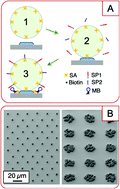Integrating nucleic acid sequence-based amplification and microlensing for high-sensitivity self-reporting detection†
Abstract
We use electron-beam patterned functional microgels to integrate self-reporting molecular beacons, dielectric microlenses, and solid-phase and/or solution-phase nucleic acid amplification in a viral-detection microarray model. The detection limits for different combinations of these elements range from 10−10 M for direct target-beacon hybridization alone to 10−18 M when all elements are integrated simultaneously.



 Please wait while we load your content...
Please wait while we load your content...